Streaking Caddis
Originators: Kenneth Boström and Lennart
Bergqvist
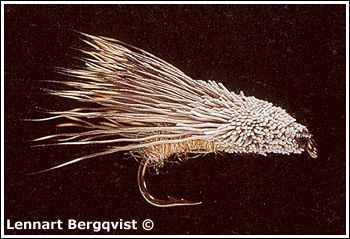
We tried for several years to come up
with a fly that have both the correct silhouette and also was floating real well, to
imitate the biggest caddis. The fly Rackelhanen, which we considered was the best imitation for
small and medium sized flies (hook size 10-18) but when imitating real big caddis
requiring sizes from 8 and larger hooks they where just to heavy to float well.
We had also tried traditional flies as
the Goddards Sedge but this fly shown to be wrong for the real "picky"
trout, we thought it has to do with the very sharp silhouette it creates. A live
caddis on the water surface is always moving its wings and therefore we wanted a more
diffuse silhouette, this is probably why the Rackelhanen works so well with imitating smaller caddis.
Therefore the material used to create a good caddi imitation is very important . "The
Streaker" a fly by Poul Jorgensen gave us the idea to use deer hair and also how
to tie it on the hook.
This is how we tie imitations of the
biggest caddi flies, (imitating Phryganea Grandis and other big caddis) We call this
fly "Streaking Caddis":
Hook: Mustad
94840, size 8.
Thread: Monocord B, or any other strong thread.
Rear body: Fly-Rite #20, dark tan.
Front body: Deer hair.
Wing: Deer hair.
Steps:
1. Dub the rear body
(wax the thread before) with Fly-rite and form a thick body that reaches down to the bend.
Save space in front, shown on photo. (The body can also be made out of deer hair that you
tie on using the same technique as forming the front body).
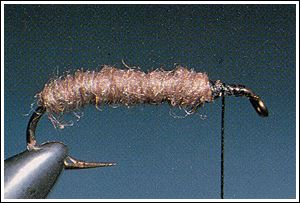
2. Use a stack of deer
hair (thick as a lead pencil). Hold the stack in your right hand and size the correct wing
length. The wing shall reach 8-10 mm behind the back body. (Do not use waxed thread to tie
on the deer hair)
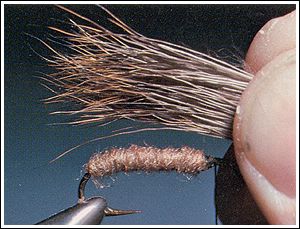
3. Change hands, grab
the stack with your left hand without moving the stack from the hook position and place
two wraps of thread around the stack and hook shank.
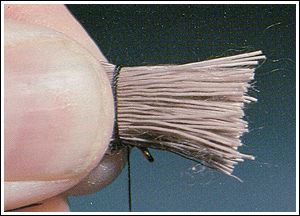
4. Tighten the thread
hard to flare deer hair as shown, still keeping the grip of the stack. Continue to wind 3
or 4 wraps through the flared hair. When reaching the hook eye pull back the hair and wind
some more wraps to secure the thread, make a whipfinish knot and cut the thread. (Imortant;
do not let go of the stack until you wrap the thread all the way to the front.)
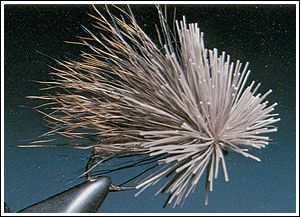
5. Trim hair into shape.
Only trim it by cutting from the back. Form the front body and head. Do not cut any hair
from the sides. (this will help the fly to stand correctly on the water surface) When
viewing the finished fly from the front, the front body should be triangle-shaped, with a
flat cut bottom, this will also make the fly to stand correctly on the surface.
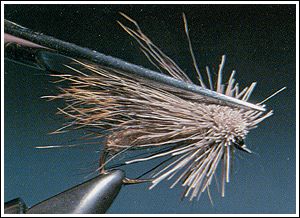
6. Finished fly should
look like this. (23-28 mm long for imitating Phryganea Grandis)

Notes:
- Trim hair in a triangle shape as seen in
below photograph.
- This Dry fly imitates the Phryganea
Grandis, the largest caddis fly in Scandinavia. You can also use this pattern to imitate
smaller caddis by reducing the hook size. You can also use colored deer hair to imitate
your local caddis better, or mix grey and brown deer hair.
- Impregnate the fly before use.
-
Text by Kenneth Boström and Lennart
Bergqvist © |